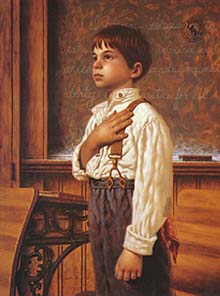I Pledge Allegiance to the Flag of the United States of America and to the Republic for which it stands, one nation under God, indivisible, with liberty and justice for all.
Original Version:
"I pledge allegiance to my Flag and the Republic for which it stands, one nation, indivisible, with liberty and justice for all."
On September 8,1892, the Boston based "The Youth's Companion" magazine published a few words for students to repeat on Columbus Day that year. Written by Francis Bellamy, the circulation manager and a native of Rome, New York, and reprinted on thousands of leaflets, was sent out to public schools across the country. On October 12, 1892, the quadricentennial of Columbus' arrival, more than 12 million children recited the Pledge of Allegiance, thus beginning a required school-day ritual.
At the first National Flag Conference in Washington D.C., on June 14, 1923, a change was made. For clarity, the words "the Flag of the United States" replaced "my flag". In the following years various other changes were suggested, but were never formally adopted.
It was not until 1942 that Congress officially recognized the Pledge of Allegiance. One year later, in June 1943, the Supreme Court ruled that school children could not be forced to recite it. In fact, today only half of our fifty states have laws that encourage the recitation of the Pledge of Allegiance in the classroom!
In June of 1954 an amendment was made to add the words "under God". Then President Dwight D. Eisenhower said, "In this way we are reaffirming the transcendence of religious faith in America's heritage and future; in this way we shall constantly strengthen those spiritual weapons which forever will be our country's most powerful resource in peace and war."
![]()


